Abstract
During the summer of 2020 the excavation team at Hohle Fels Cave in the Ach Valley of southwestern Germany recovered a leaf point (in German Blattspitze) made from gray Jurassic chert. The find is well-preserved and remarkable for a number of reasons. First this is the only leaf point recovered by a modern excavation in the Swabian Jura, and is the first leaf point discovered in situ since 1936, when Gustav Riek’s crew recovered two well-preserved leaf points at the excavation of Haldenstein Cave in the Lone Valley. The leaf point and associated finds originate from archaeological horizon (AH) X, 120 cm below the base of the rich Aurignacian deposits at the site that dates with radiocarbon to ca. 42 ka cal BP. Four ESR dates made on the teeth of large mammals from AH IX overlying the new leaf point yielded an average age of 62.5 ± 4 ka BP. This date represents a minimum age for the new horizons, which based on convention would be placed in the cultural taxonomic unit of the Blattspitzengruppe. Since the Blattspitzengruppe is typically interpreted as the last Middle Paleolithic cultural unit, we were intrigued to find an assemblage containing a Blattspitze in such an early chronostratigraphic context. While in Germany the Blattspitzengruppe is usually associated with the end of the Middle Paleolithic, many researchers across Europe have described these leaf point assemblages as being transitional industries at the interface between the Middle and Upper Paleolithic. Historically, some authors have even suggested a degree of cultural continuity between leaf point assemblages of the Middle and Upper Paleolithic. Here we present the stratigraphic and chronological context of the AH X and provide a preliminary description of the material cultural record from this horizon. Keeping in mind that we so far have only excavated parts of 6 m2 of the new find horizon and the underlying find horizon AH XI, the paper provides initial observations that will need revision as the excavation proceeds. These findings suggest that leaf points represent a feature in the technological repertoire of the Late Pleistocene Neanderthals of southwestern Germany rather than a reliable cultural stratigraphic marker for the last phase of the Middle Paleolithic.
Introduction
Early research into the Paleolithic of the Swabian Jura dates back to the beginnings of Ice Age archaeology in Central Europe in the 1860s (Fraas 1862). In the 1860s Oscar Fraas, who worked at the Königliches Naturalienkabinett in Stuttgart, conducted excavations at Hohlenstein-Bärenhöhle in the Lone Valley. Here, after initially having overlooked stone artifacts due to his focus on Ice Age fauna, he identified Middle Paleolithic finds that in the late 19th century were known to be associated with Neanderthals. Following his well-known excavation at the Schussenquelle near Bad Schussenried in 1866 (Fraas 1866, 1867; Schuler 1994), in 1870 and 1871 Fraas together with the pastor Theodor Hartmann began excavations at Hohle Fels in the Ach Valley (Fig. 1) on the northeastern edge of the town of Schelklingen (Fraas 1872; Conard and Wolf 2020; Walter 2021). This work led to the recovery of Magdalenian and Gravettian finds at Hohle Fels. Subsequent excavations most notably by Gustav Riek in 1958-1960 and by Joachim Hahn with interruptions from 1977-1996 also recovered significant material from the Magdalenian and the Gravettian. While Riek never published the results of his poorly documented excavations (Saier 1994), Hahn and his team published numerous field reports and a number of articles on this phase of research (Scheer 1994, 1999).
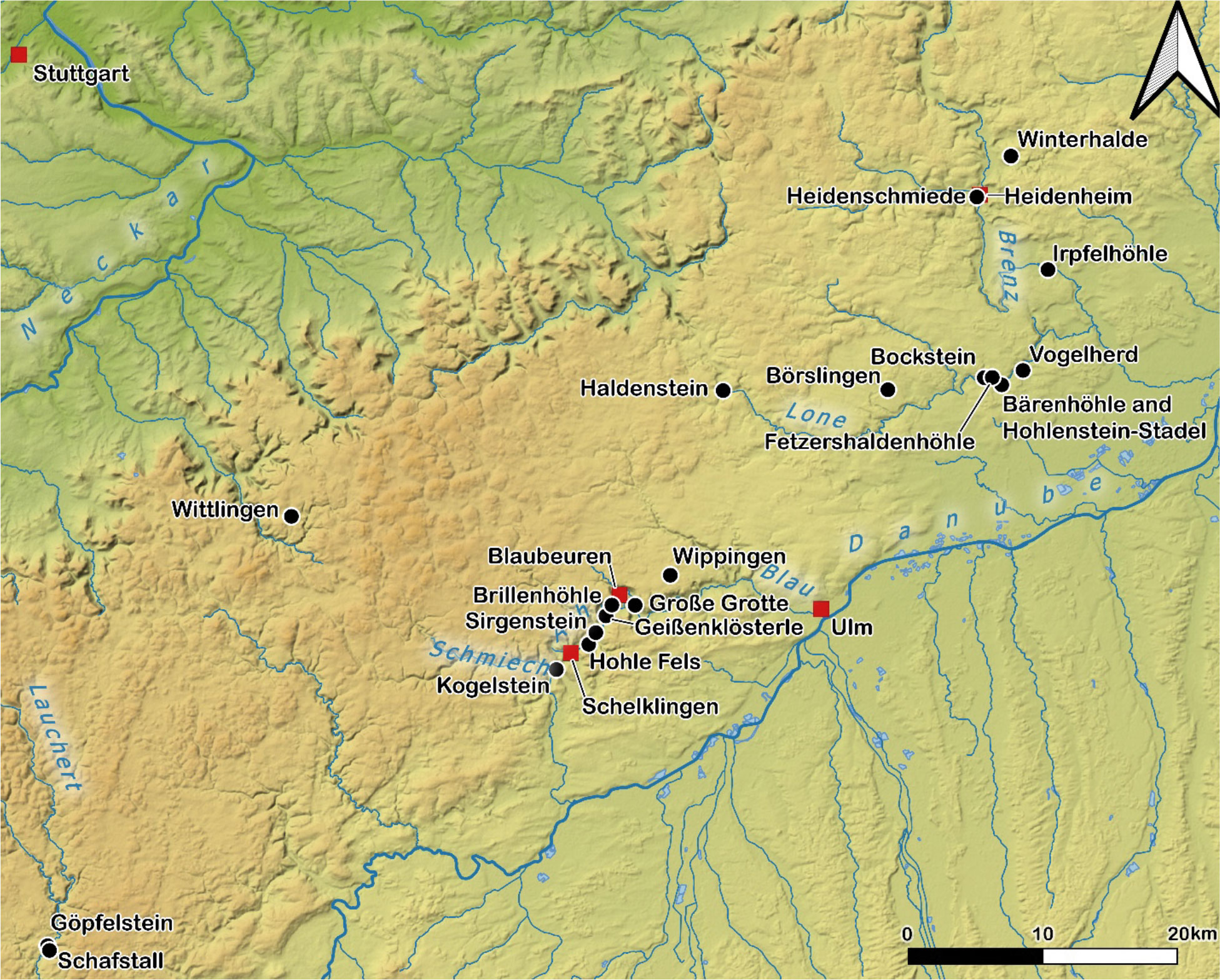
Following Hahn’s death in 1997, Conard continued field work at Hohle Fels with excavations taking place every year from 1997-2021. This phase of research over the last 25 seasons has led to numerous important contributions to the region’s Paleolithic record (Conard and Wolf 2020). Important in the current context is that this work, while greatly augmenting the Magdalenian and Gravettian assemblages from Hohle Fels, also uncovered a remarkably rich Aurignacian sequence that has received much international attention (Conard 2003, 2009, 2011, 2015; Conard and Bolus 2003; Conard et al. 2009; Bataille and Conard 2018) and a long Middle Paleolithic sequence, which has been described in a number of preliminary reports (Conard et al. 2012).
Among the important observations from the Middle Paleolithic of Hohle Fels is the radical drop of find density in the strata underlying the base of the Aurignacian deposits. This confirmed the observation from many other sites, including nearby Sirgenstein (Schmidt 1907, 1912) and Geißenklösterle (Hahn 1988; Conard et al. 2019a), that an occupational hiatus, or at a minimum a sharp drop in regional occupational intensity, separates the late Middle Paleolithic from the Aurignacian, thereby indicating that modern humans associated with the Aurignacian arrived in this part of the Upper Danube drainage during a period in which few or no Neanderthals occupied the regions (Conard et al. 2006). As the excavation team dug deeper into the Middle Paleolithic strata of Hohle Fels the densities of archaeological materials remained low for the most part, indicating that the cave was repeatedly visited by Neanderthals and that they usually inhabited the site for short periods in relatively small groups (Conard et al. 2006, 2012). This situation is broadly similar to that documented at the nearby site of Geißenklösterle 2 km further downstream in Ach Valley (Conard et al. 2019b). For the first time in 2020, excavators reached Middle Paleolithic deposits with much higher find densities that form the focus of this paper.
Stratigraphy of the Middle Paleolithic horizons
Following the conventions going back many generations in the Swabian Jura, geological horizons (GHs) are designated by Arabic numbers and archaeological horizons (AHs) by Roman numeral (Schmidt 1912; Bolus and Conard 2012). Over the course of excavation at Hohle Fels the team has identified six main Middle Paleolithic GHs that correspond to six AHs. These layers are all characterized by a matrix of silty clay with varying amounts of limestone debris from the ceilings and walls of the cave. The matrix comes from sediments that entered the cave through a chimney at the back of the cave and through cracks in the roof. Fine grain sediments also originate from weathered limestone and aeolian input from the entrance of the cave (Miller 2015). The bulk of the sediment accumulated to form a sediment cone in the main hall of the cave. The strata from the Middle Paleolithic at Hohle Fels correspond to GH 9 – 14 and AH VI – XI (Conard and Janas 2021).

Figure 2 presents north-south Profile 2 that provides an overview of the sequence, although, due to lateral facies shifts, the details of the sequence vary depending where one examines the stratigraphy. In general, the layers slope downward toward the north and the west (Fig. 3). This corresponds to a slope downward from the sediment cone in the main hall of the cave toward the entrance of the cave which opens toward the Ach River (Hahn 1999; Miller 2015; Barbieri et al. 2018, 2021). Depending on climatic conditions the surface of the cave could be relatively stable, but phases of downslope movement were common, and a major phase of erosion out the entrance to the cave with deposition toward the floodplain of the Ach Valley occurred in connection with the Last Glacial Maximum (LGM). This creates a situation in which the Magdalenian deposits rest directly on the Gravettian deposits with no sediments from the LGM. Barbieri and colleagues (2018, 2021) have reconstructed this process in detail and have documented the presence of sediments originating from the cave in front of Hohle Fels. Distinctive erosional channels are also visible at the top of the Gravettian deposits, which makes it difficult to separate cleanly the clayey silts that form the matrix of both the Gravettian and Magdalenian deposits (Scheer 1999). Such major phases of erosion are limited to the LGM and there appear to be no major sedimentary gaps in the Gravettian, Aurignacian and Middle Paleolithic sequences (Miller 2015). The zones of low find density between the Middle Paleolithic and the Aurignacian deposits and between the Aurignacian and Gravettian deposits (Fig. 3) support the hypotheses for discontinuity in the use of the site between these perods (Conard et al. 2006; Conard and Moreau 2004).
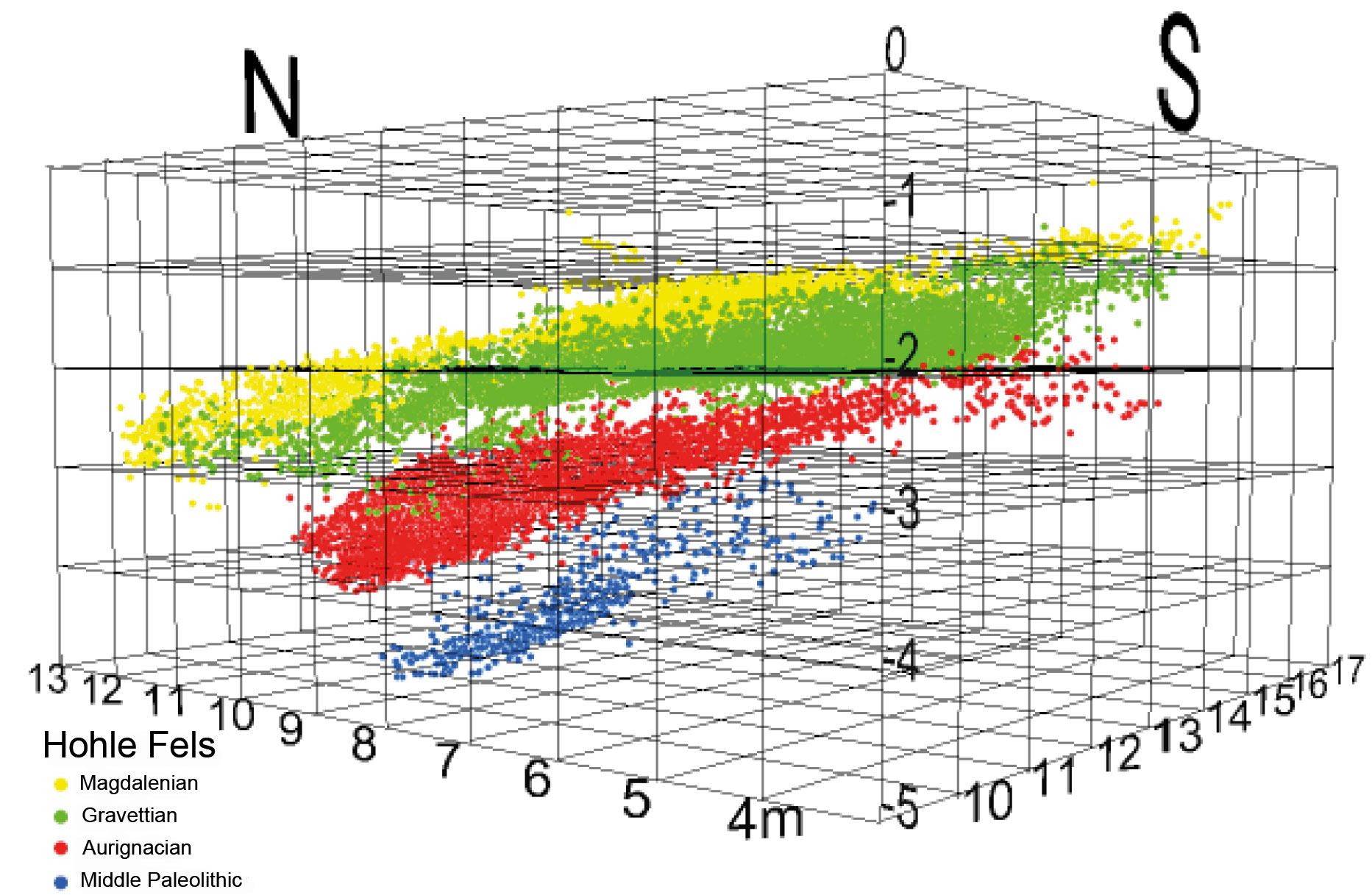
The Middle Paleolithic deposits at Hohle Fels have characteristics that suggest a distinct mode of deposition when compared with those from the Upper Paleolithic (Miller 2015). In particular, AH IX and AH VIII are composed of calcareous clay that has been partially altered to phosphate through the decay of organic matter. Layers of clay that exhibit a clear horizontal orientation characterize these deposits, and are particularly prominent in AH IX. This suggests that, in contrast to the Upper Paleolithic deposits, low-energy flowing water played a role in the accumulation of these Middle Paleolithic layers. Other evidence for the role of water as a depositional agent can be found in AH IX, which contains clay intercalation and silty clay infillings. Sandsized phosphate grains are common within both layers and are mainly derived from carnivore coprolites. Although similar grains are found throughout the Pleistocene deposits at Hohle Fels, they are noticeably more frequent in the Middle Paleolithic layers. In contrast to the coprolite fragments found in the Upper Paleolithic deposits, those found in the Middle Paleolithic are generally angular and subangular, indicating a low influence of downslope movement and cryoturbation on these layers (Miller 2015). Micromorphology samples from AH IX and AH VIII lack evidence for anthropogenic input, although lithic artifacts in both layers attest to a low level use of the cave by Neanderthals.
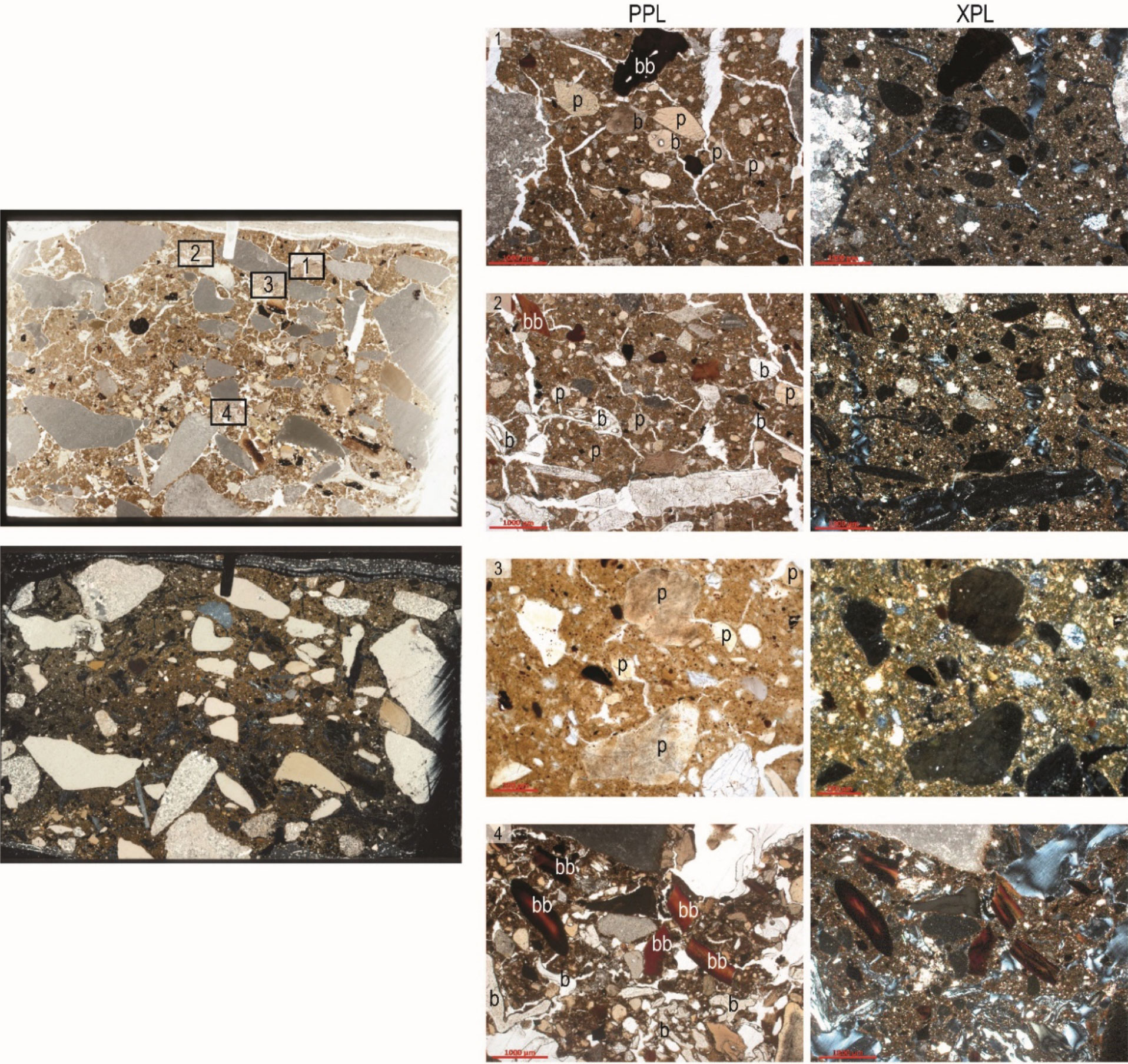
Recent analysis of geoarchaeological samples from AH XI paint a more nuanced picture of depositional processes acting at Hohle Fels during the Middle Paleolithic. Block sample HF-203123 includes sediments from AH XI and part of a combustion feature, designated AH XI Feature 1. As in AH VIII and AH IX, the matrix appears as partially phosphatized calcareous clay, but lacks any visible bedding structures (Fig. 4). The coarse components include sand-sized grains of phosphate, burnt and unburnt bone fragments, and fine gravel-sized fragments of limestone which exhibit both random and sub-horizontal, parallel orientations. Anthropogenic input into AH XI is much more pronounced when compared with AH VIII or AH IX, and it becomes predominant within the Feature 1 (Fig. 4). Micromorphological samples confirm that cryoturbation generally does not impact the accumulation of the Middle Paleolithic layers at Hohle Fels. Comparing AH XI with the stratigraphically higher layers of AH VIII and AH IX, we see that running water played a more significant role in later phases of the Middle Paleolithic, although slope action may account for the presence of oriented fragments of limestone found in AH XI. AH XI also records evidence for a marked increase in anthropogenic input to the deposits, in the form of burnt and unburnt bone fragments.
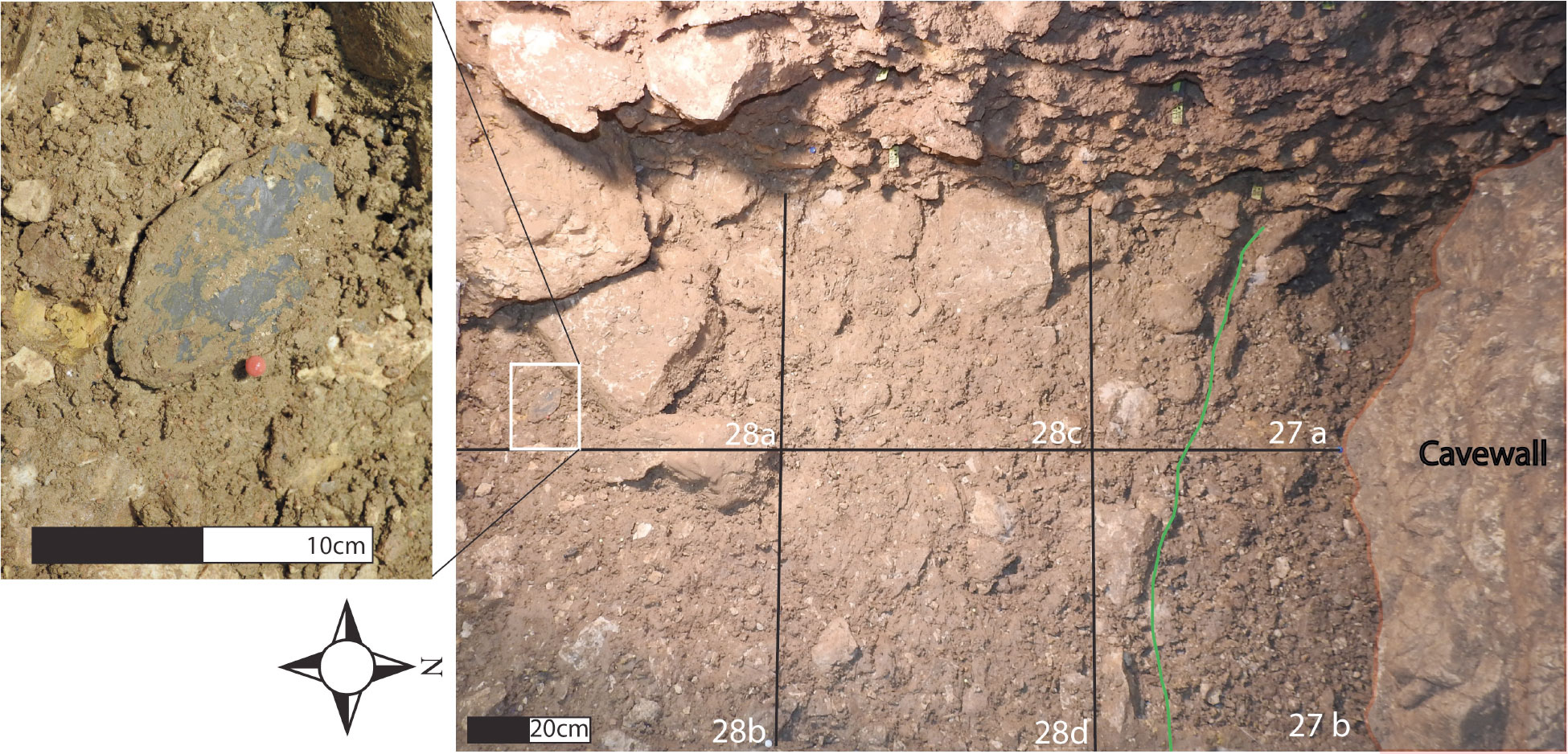
Discovery and context of the new leaf point
On July 2, 2020 Mario Mata-Gonzalez excavated a leaf point, in German Blattspitze, knapped from Jurassic chert from the Swabian region. The find lay in a silty-clay matrix with angular and slightly rounded limestone fragments and blocks of limestone debris with dimensions up to 2030 cm (Fig. 5, Fig. 6). The Blattspitze lay in AH X in a roughly horizontal position about 1.2 meters south of the wall of the cave in sediments containing numerous lithic artifacts and fragments of burnt bone and diverse faunal material. It is difficult to comment on the spatial distribution of finds since so far only parts of six square meters have been excavated. What, however, is clear is that the leaf point comes from deposits with far higher find densities of all classes of archaeological material than the overlying deposits of AH IX, VIII, VII and VI (Fig. 7). Clearly, Neanderthals were spending more time in Hohle Fels during this phase of occupation and presumably engaging in more diverse activities than during the subsequent phases of occupation.
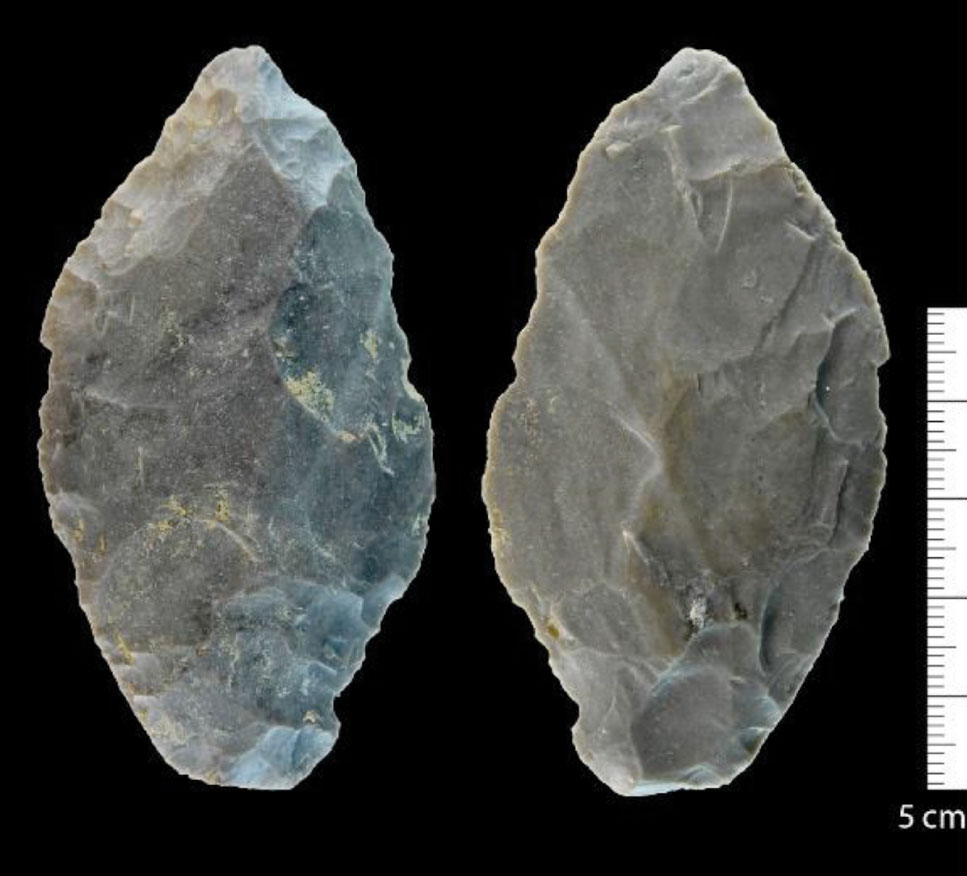
The new leaf point has dimensions of 7.6 cm long, 4.1 cm wide, 0.9 cm thick and weighs 28 grams. An accompanying paper in this volume presents a detailed techno-functional assessment of the Blattspitze and concludes that it served as a projectile point, most likely hafted on a thrusting spear, although further research and larger samples of such tools would be helpful in testing this interpretation (Rots et al. 2021). Here we focus our attention on the stratigraphic, chronological and archaeological context of the find and consider the implications of this artifact.
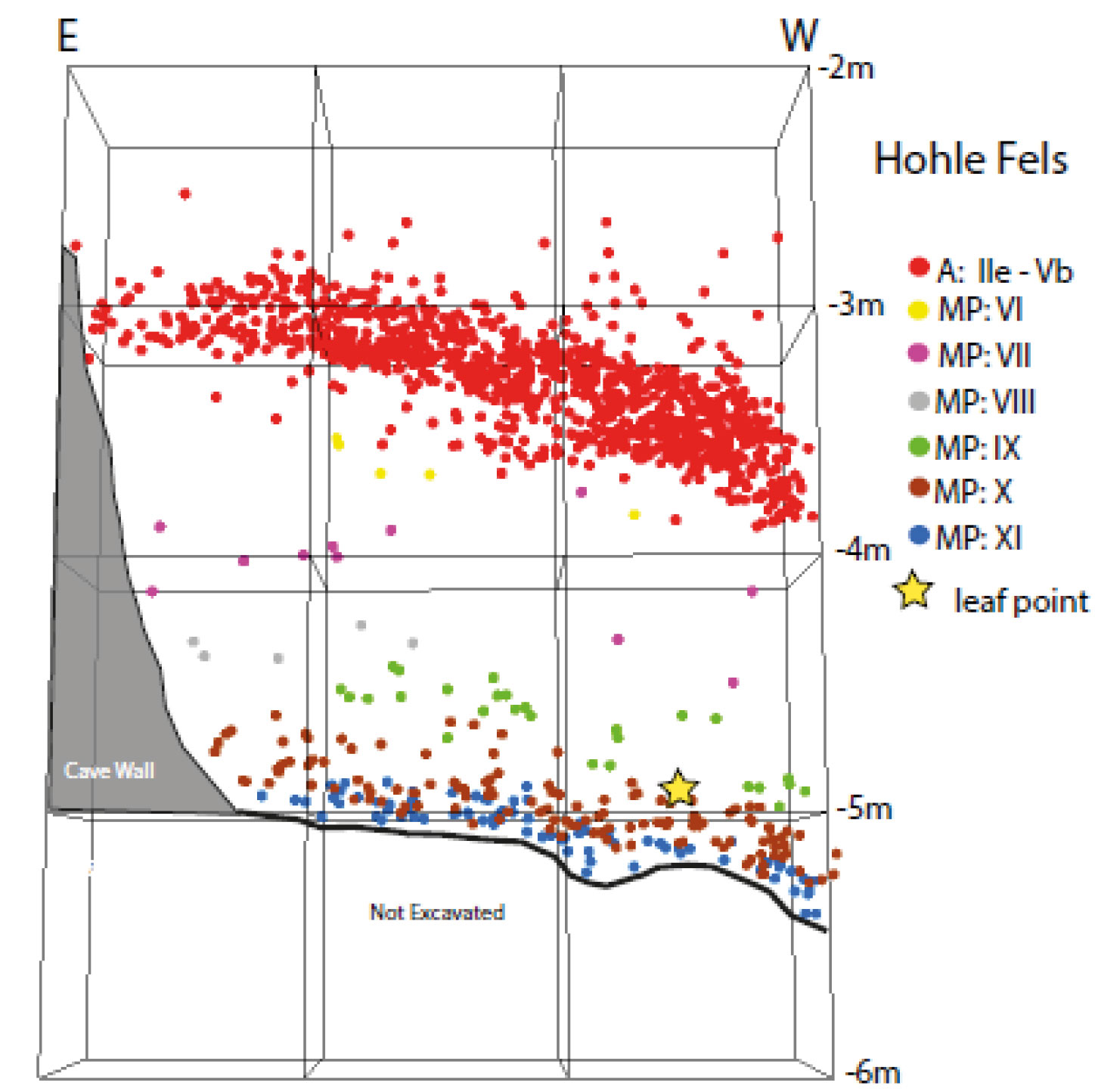
Leaf points and the Blattspitzengruppe of central Europe have long been viewed as belonging to the last phase of the Middle Paleolithic (Bosinski 1967; Conard and Fischer 2000; Bolus 2013). Prior to our work, the best-preserved leaf-points from the Swabian Jura came from Haldenstein Cave near the source of the Lone and were discovered by Gustav Riek’s team in 1936 (Fig. 8, Fig. 9) (Riek 1938). The new find which underlies the base of the Aurignacian deposits at Hohle Fels by 1.2 meters as well as multiple Middle Paleolithic find horizons shows that the leaf point and the other finds from AH X were not used by late Neanderhals during the final phase of the Middle Paleolithic. The base of the Aurignacian in the Ach Valley sites of Hohle Fels and nearby Geißenklösterle dates to roughly 42 ka cal BP (Conard 2009; Higham et al. 2012; Bataille and Conard 2018). The last Middle Paleolithic horizons in the Swabian Caves usually date to roughly 45 ka BP (Richter et al. 2000; Higham et al 2012; Richard et al. 2019). To determine the age of AH X and the new leaf point, new radiometric dates would be needed.
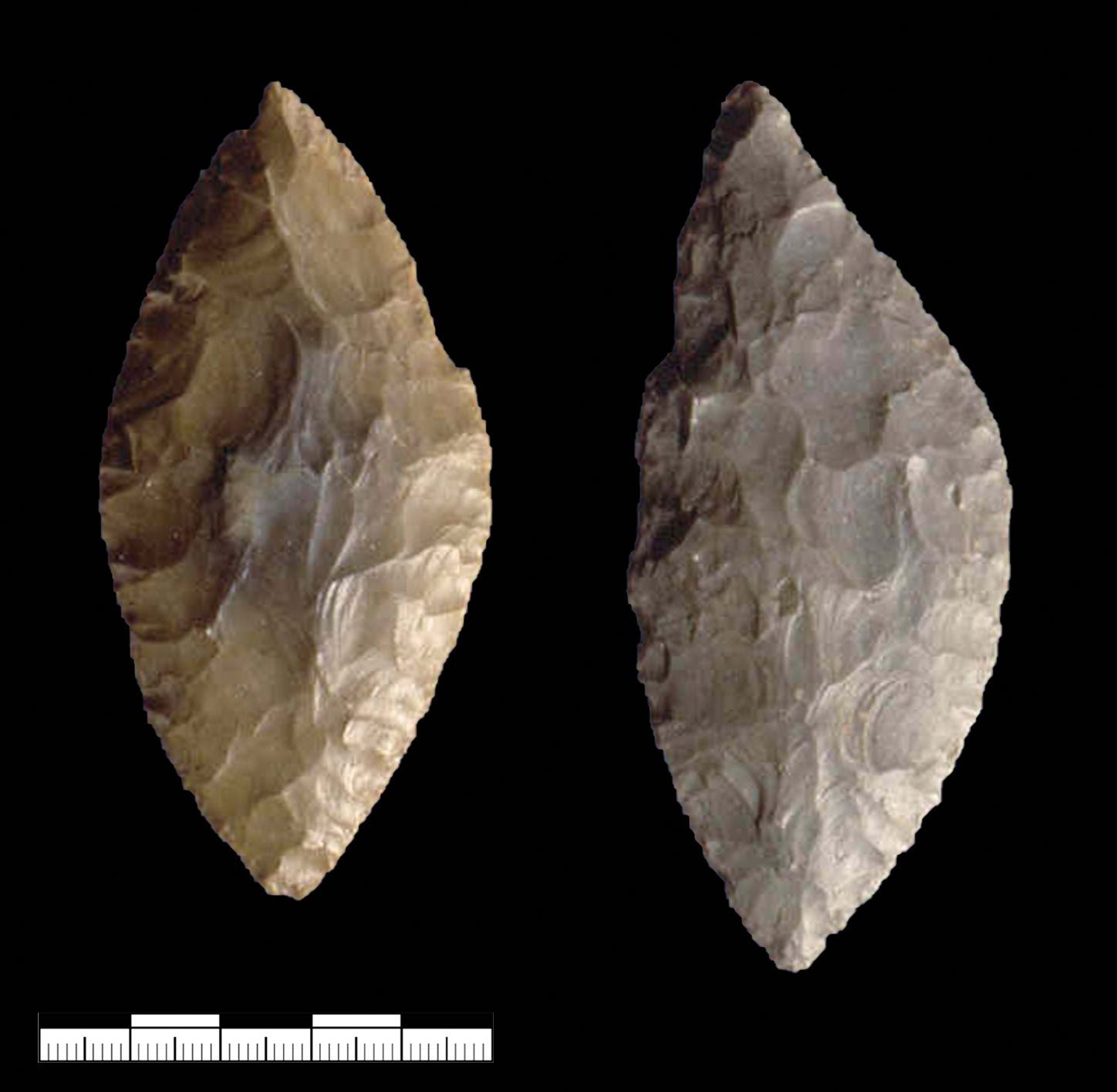
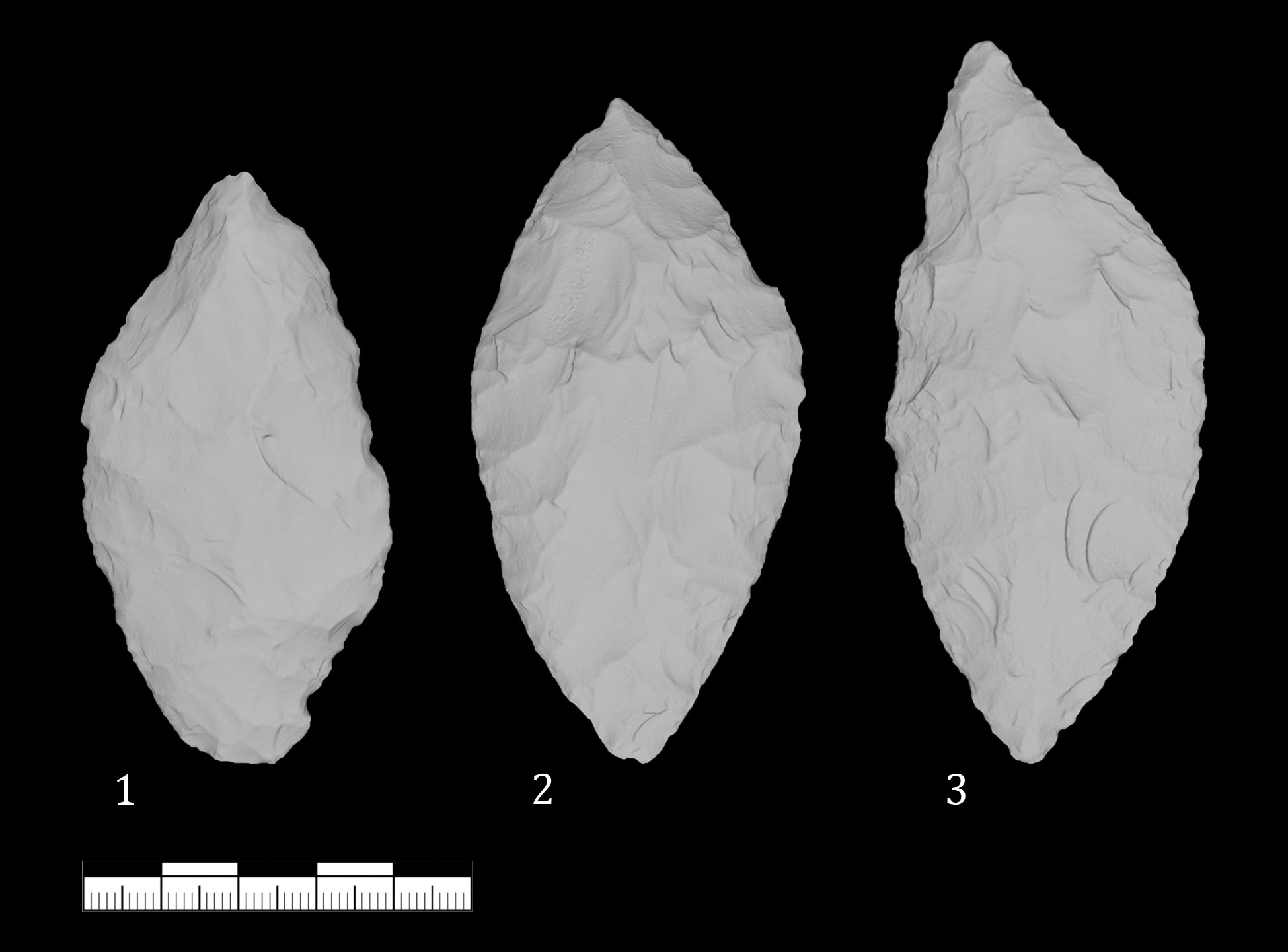
Radiometric dating
Working closely with the excavation team and Chantal Tribolo in Bordeaux, Maïlys Richard, who earlier conducted ESR/U-series dating at Geißenklösterle and Hohlenstein-Stadel (Richard et al. 2019, 2020) agreed to use the same methods to try to establish a chronology for the Middle Paleolithic of Hohle Fels, which dates beyond the reliable limit of radiocarbon dating. We sampled four herbivore teeth including one equid molar, one rhinoceros molar, and two cervid molars (Table 1), from AH IX for combined electron spin resonance-uranium series (ESR/U-series) dating. These finds all overlay the AH X, which yielded the new leaf point in 2020. This dating method is based on the property of the enamel hydroxyapatite to record a dose of ionizing rays produced from radioactive disintegrations in the sample and the surrounding sediment, as well as from cosmic rays. The teeth themselves provide radiation from U-series decay, while the sediments contribute radiation from U and Th-series decay, and from radioactive K. The dose absorbed is a function of the burial time and the radioactivity to which the teeth have been exposed. An age is obtained by dividing the equivalent dose – the dose recorded by the sample since burial – by the dose rate, which corresponds to the radioactive dose received per year.

Richard prepared and measured samples according to the procedure for ESR and U-series dating in established protocols (Richard et al. 2015). The carbonate hydroxyapatite T1-B2 signal (Grün 2000) was measured five times on one natural aliquot and 10 artificially irradiated aliquots (from 2.2 to 150 Gy) using an EMX micro-6/1 Bruker ESR spectrometer. Irradiation using a Gammacell-1000 equipped with a 137Cs source and measurements took place at the CENIEH (Burgos, Spain). The U-series measurements were conducted at the LSCE (Gif-sur-Yvette, France). U and Th fractions were combined for the measurement on a Multi-Collector inductively coupled plasma mass spectrometer (MC-ICP-MS) Thermo Scientific TM Neptune Plus fitted with a jet pump interface and a desolvating introduction system (aridus II) following PonsBranchu et al. (2014). We used U-content, 234U/238U and 230Th/234U to model the alpha and beta dose rate from the dental tissues (enamel, dentine and, for the equid tooth, cementum) using the US model (Grün et al. 1988) with the DATA program (Grün 2009). The gamma dose from the sediment and the cosmic dose rate were measured in situ using Al2O3:C dosimeters, placed in the section for 12 months and analyzed following Kreutzer et al. (2018). We used a mean value of 167 ± 16 μGy/a for the age calculation. For all samples, except for HF 2956 that was covered by cementum (see Table 1), we derived the beta dose rate from U, Th and K content measured in the sediment using a high resolution low-background gamma-ray spectrometer applying the conversion factors of Adamiec and Aitken (1998) available in the DATA program.

Table1, Table 2 and Figure 10 report the ages for the four samples. Richard calculated ages using the US model except for HF 2956, for which an early uptake (EU) was assumed (Table 2). Indeed, for this sample, high 230Th/234U in the enamel (0.9165 ± 0.0131), limits the use of the US model, because the U-series age on this tissue is higher than the EU age (Grün et al. 1988). However, due to low U-content in the teeth (< 5 ppm; Table 2), the alpha and beta dose rates from the dental tissues are negligible. Thus, EU or US age cannot be distinguished except for HF 2997, for which positive p-values describe a recent uptake. The combined ESR/U-series ages range from 72 ± 8 ka (HF 2997) to 59 ± 10 (HF 3008). Based on the four results, we obtained a weighted mean age of 63 ± 4 ka for the AH IX overlying the AH X from where the Blattspitze originated. This result from four distinct measurements on teeth of large mammals confirms our suspicion that the Blattspitze does not come from the end of the Middle Paleolithic.
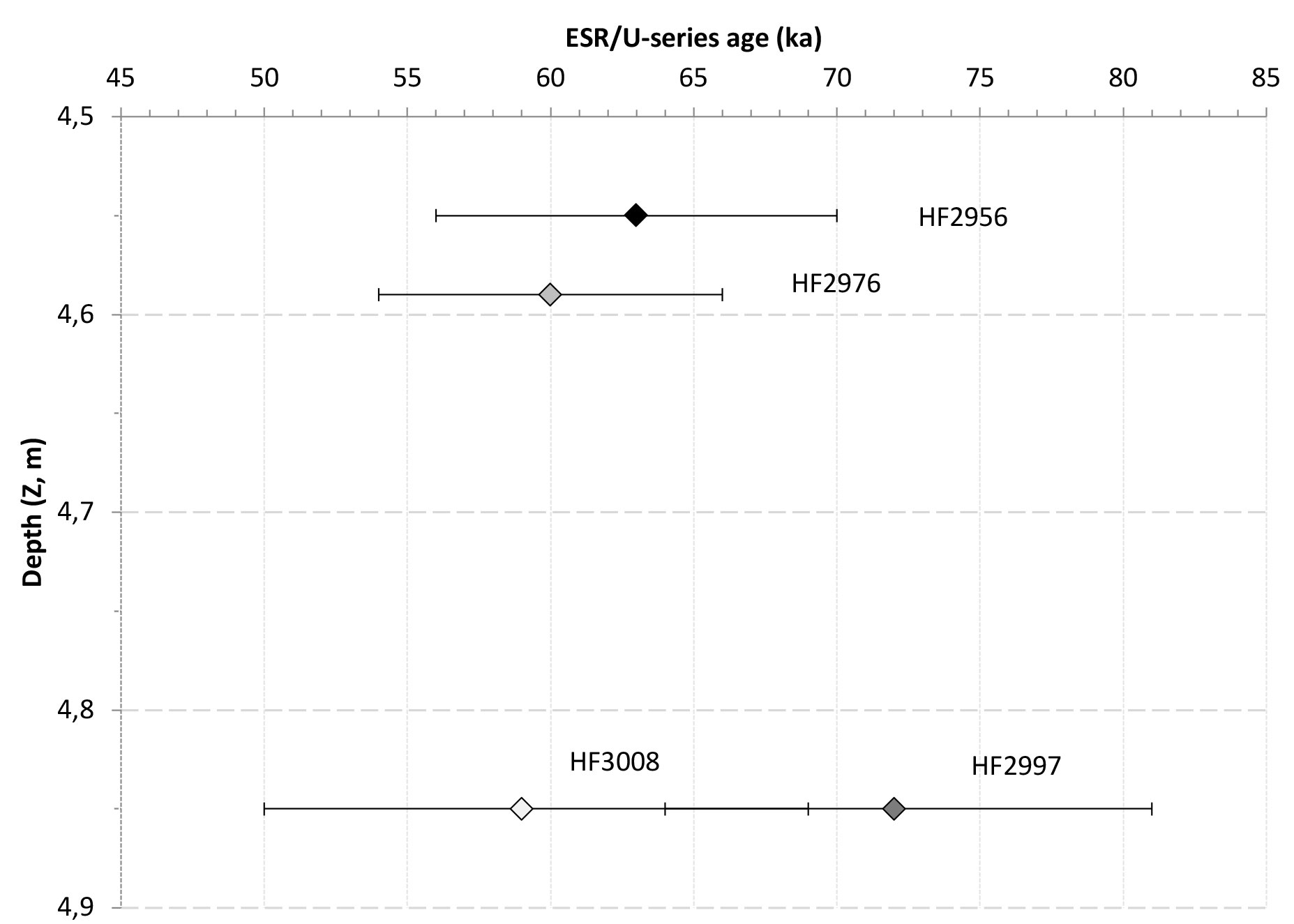
Find densities and the lithic assemblage of AH X
The following description of lithic finds from the Middle Paleolithic layers of AH X and XI is based on piece-plotted finds and the finds recovered waterscreening during the excavation campaigns of 2019 and 2020. While we focus on AH X, we present information on the other assemblages from Hohle Fels to provide an overview on the Find densities and the lithic assemblage of AH X The following description of lithic finds from the Middle Paleolithic layers of AH X and XI is based on piece-plotted finds and the finds recovered waterscreening during the excavation campaigns of 2019 and 2020. While we focus on AH X, we present information on the other assemblages from Hohle Fels to provide an overview on the size and general features of the Middle Paleolithic assemblages (Fig. 11). Only small parts of layers X (V=0.2 m³) and XI (V=0.8 m³) size and general features of the Middle Paleolithic assemblages (Fig. 11). Only small parts of layers X (V=0.2 m³) and XI (V=0.8 m³) have been excavated so far. Nonetheless, it is already apparent that AH X and XI are very rich in finds compared to the overlying Middle Paleolithic horizons. So far, AH X and XI have produced 1,165 and 842 lithic artifacts, with lithic densities of 1,456 and 4,210 finds per m³ (Fig. 12). The overlying AHs VI – IX have far lower find densities ranging from 216 – 310 finds per m³. The proportions of lithic artifacts, burnt bones and faunal remains also show noteworthy variation with lithic artifacts and burnt bones being more abundant in AH X and XI (Fig. 12). Faunal remains, however, are not so frequent in these horizons. This is likely the result of increased human activity during the formation of the lower layers. This increase is nevertheless far below the find densities observed for the Aurignacian (AH III, IV, Va, Vaa, Vb) (Fig. 13).
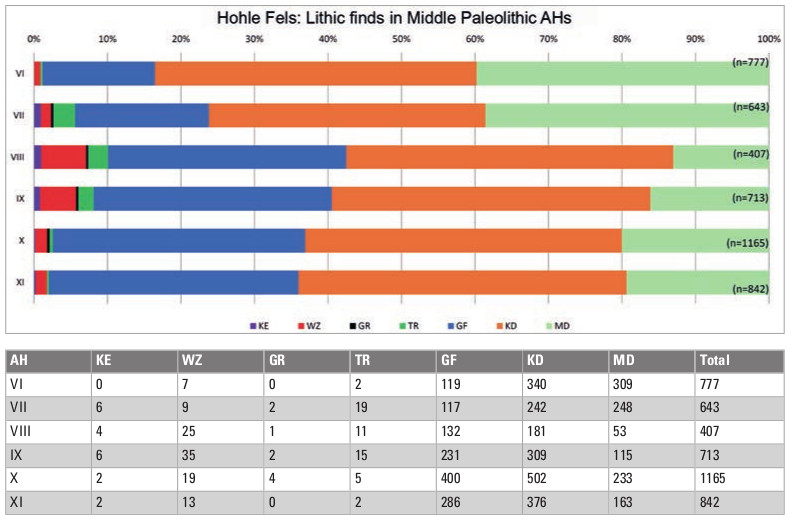
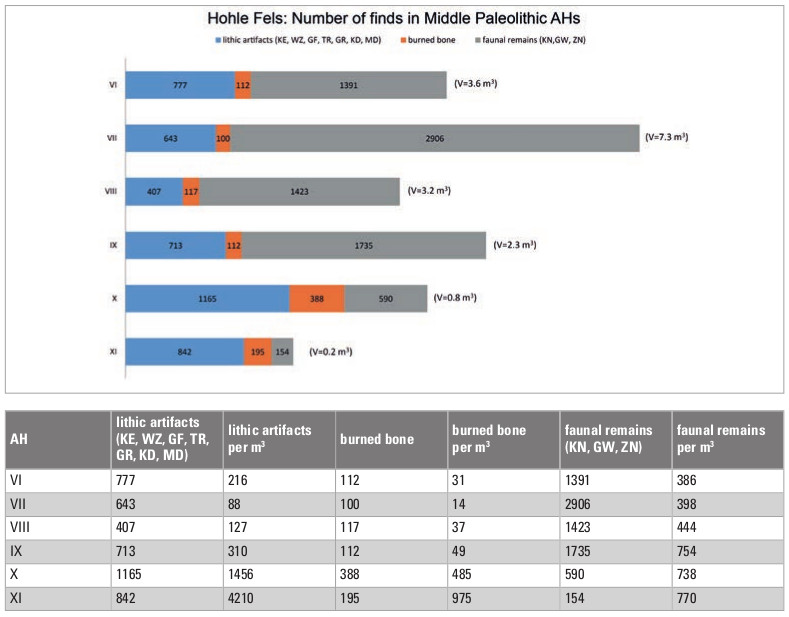
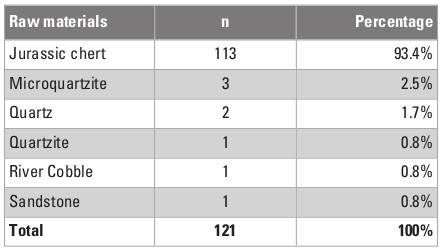
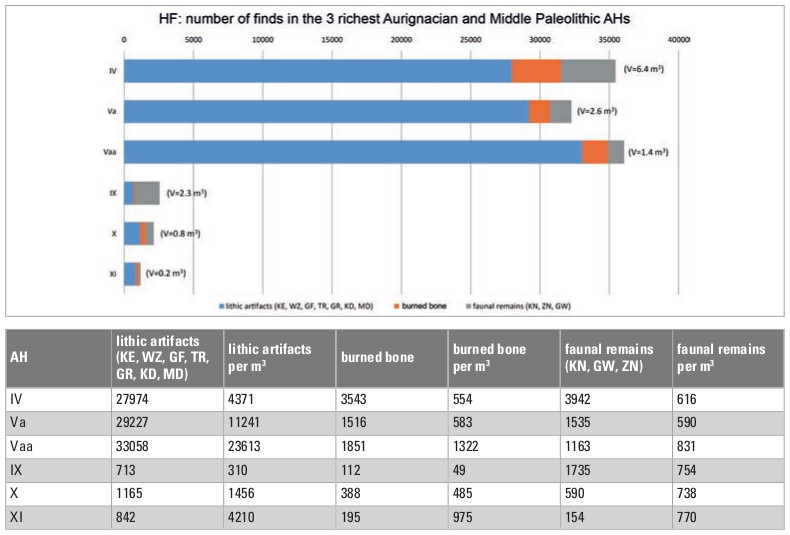
All cores from AH X except for one core of microquartzite are made of Jurassic chert (Fig. 14). Thus, no raw materials from distant raw material sources were used. In AH X, a wide variety of cores is present. They include Levallois cores (n=3), one of which with laminar preparation; cores on ventral surfaces of flakes (n=2); single platform flake cores (n=1); as well as non-diagnostic flake cores (n=2). All of these classes of cores have previously been described for the Middle Paleolithic of the Swabian Jura. Levallois cores are abundant in almost all Middle Paleolithic assemblages of the Swabian Jura (Bolus 2011; Bolus and Conard 2019; Çep 2019). Flake cores on ventral faces have been reported at Große Grotte before (Frick et al. in prep.). The combination of a Levallois core on the upper side and laminar preparation on the under-side has also been observed before at Heidenschmiede (Çep et al. 2021).

Nineteen tools are currently present in the lithic assemblage from AH X. One leaf point, four other bifacial tools, nine side-scrapers and five laterally retouched flakes (Fig. 15). Scrapers are abundant in most Middle Paleolithic horizons in the Swabian Jura. Leaf points, however, are extremely rare in the region’s the Middle Paleolithic. The other bifacial tools from AH X show bifacial knapping, but are irregular in form, incomplete or examples of unsuccessful knapping. They are not of clear cultural stratigraphic significance.
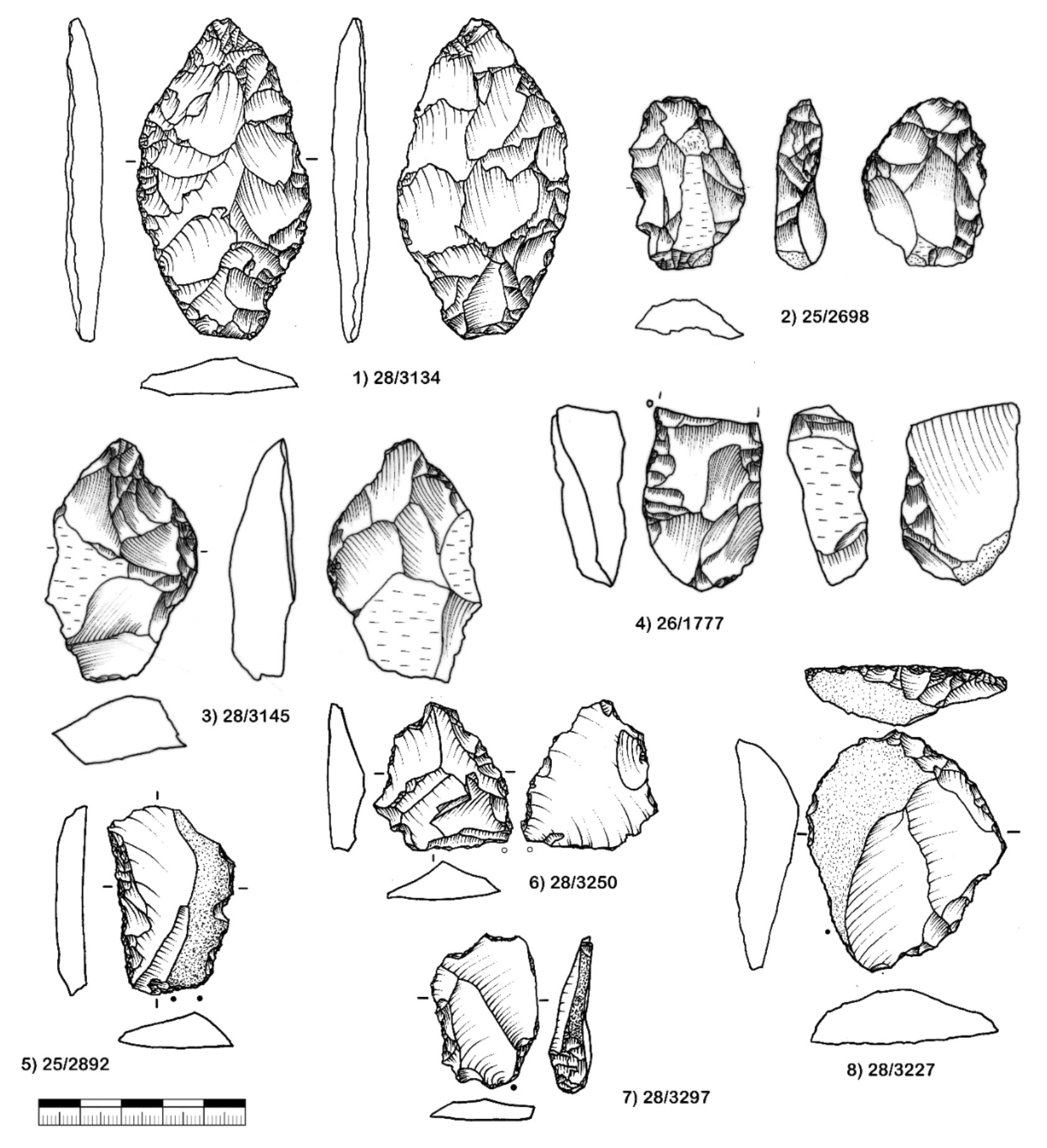
In each AH X and XI one fragment of strongly abraded sandstone is present (Fig. 16). Traces of ochre are visible in the depressions of the artifact from layer X. This piece of sandstone may have been used to produce ochre powder. Another exceptional artifact is a burnt flake of Jurassic chert (Fig 16). This piece has a black substance adhering to the proximal end. We hope that future studies will show whether or not this material represents traces of mastic.
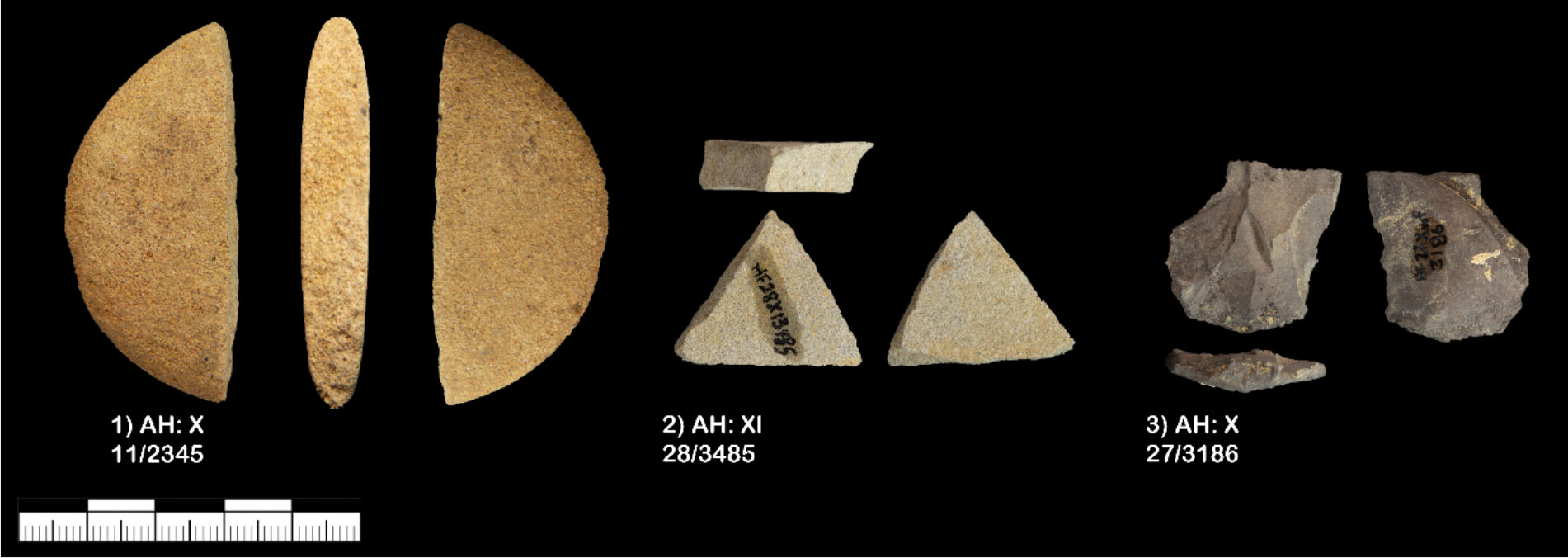
Middle Paleolithic assemblages overlying and underlying AH X
The other Middle Paleolithic horizons from Hohle Fels show a distribution of lithic raw materials similar to those of AH X (Fig. 17). Differences between the composition can mostly be seen in individual pieces of exotic raw materials. For example, in AH XI there is a single piece made of Muschelkalk chert. Today this material can be found in the river gravels of the Neckar in a distance of about 40 km. A common feature of all Middle Paleolithic strata is the presence of the Levallois artifacts. Nevertheless, other reduction concepts also occur. Layer X and XI differ from the other horizons in having more elaborated bifacial artifacts (Conard and Malina 2006, 2007, 2008, 2010, 2013, 2019, 2020; Conard et al. 2017; Conard and Janas 2018, 2021). As we gain more information on the Middle Paleolithic sequence from Hohle Fels, the site, as one of very few that have been excavated using modern techniques, should provide new insights into the cultural stratigraphic sequence of the Swabian Jura and into the changing technologies and lifeways of the region’s Late Pleistocene Neanderthals.
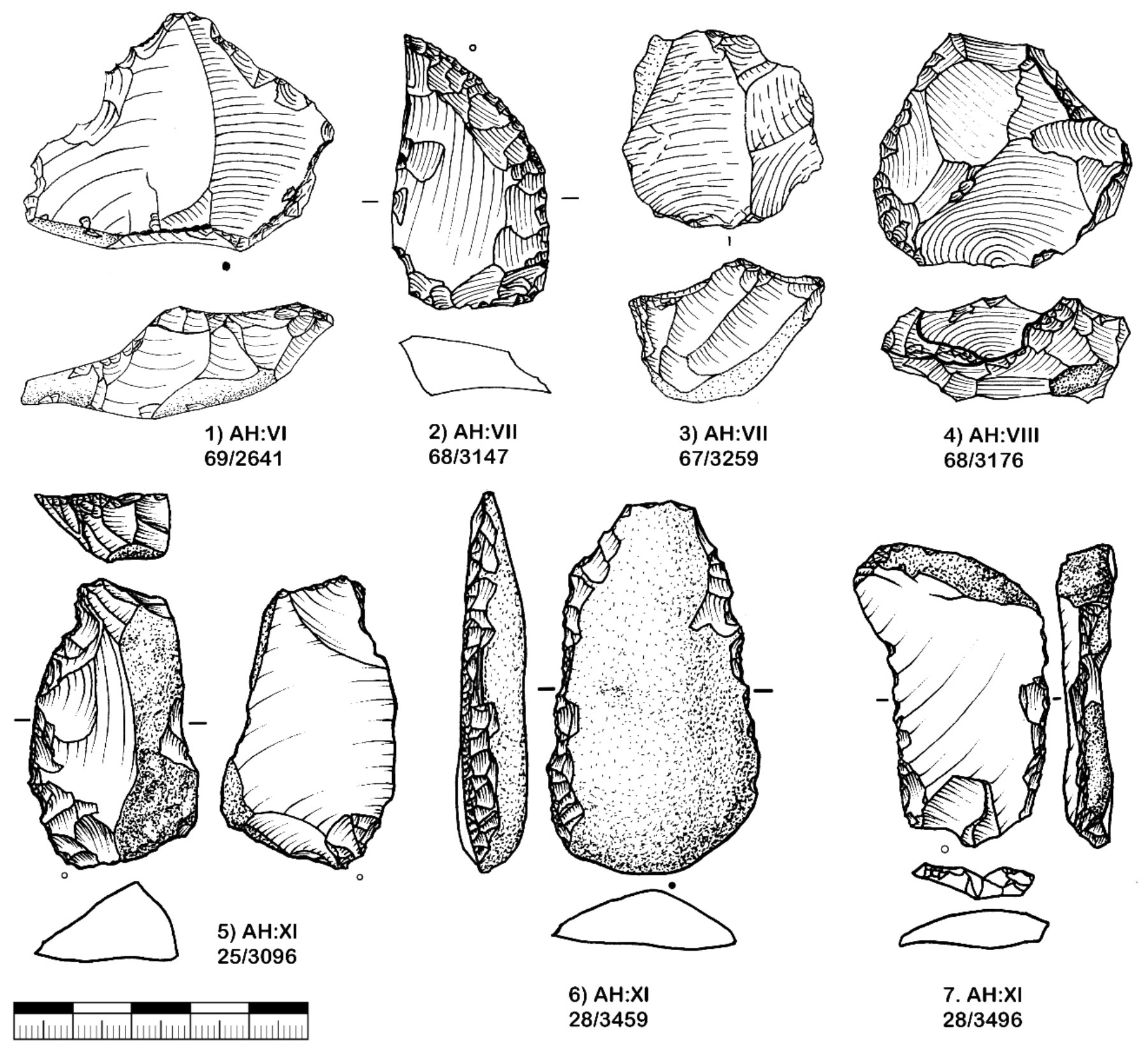
Discussion and conclusions
The ongoing excavations at Hohle Fels present a unique opportunity to revise the Middle Paleolithic cultural stratigraphic and chronostratigraphic sequence of the Swabian Jura. This is because the history of research on what in Germany is usually called the Blattspitzengruppe has often linked this cultural taxonomic unit with the Upper Paleolithic or latest Middle Paleolithic. Initially, Gustav Riek (1938) assumed that there must be some sort of link between bifacial finds from Haldenstein and the Solutrean. A generation later Gisela Freund (1952) also postulated such a link between Blattspitzen assemblages and the Solutrean. While in more recent years, very few researchers have continued to suggest such cultural connections, many researchers link Blattspitzen assemblages with the end of the Middle Paleolithic or even as a transitional industry between the Middle and the Upper Paleolithic (e.g., Müller-Beck 1956, 1983; Bosinski 1967; Allsworth-Jones 1986; Valoch 1993; Conard and Fischer 2000; Flas 2000-2001; Bolus 2004a, 2004b; Hopkinson 2004; Bolus and Conard 2019).
In the German tradition, Gerhard Bosinski’s 1967 monograph, Die mittelpaläolithischen Funde im westlichen Mitteleuropa, represents a hallmark of Middle Paleolithic research that argued that the Blattspitzengruppe corresponds to the last of the Middle Paleolithic cultural groups (Formengruppen). This view was also reflected in the key works from Hansjürgen Müller-Beck (1956, 1983), who also viewed the leaf point assemblages of the Swabian Jura and central Europe as the last phase of the Middle Paleolithic. Given that at until the late 1980s, most paleoanthropologist and Paleolithic archaeologists favored models supporting continuity between Neanderthals, who were responsible for the Middle Paleolithic, and modern humans, who were responsible for the Upper Paleolithic, it is not surprising that various leaf point assemblages across Europe were often considered to be transitional industries. The rise of prominence of models favoring the African origins of modern humans (Bräuer 1984; Stringer and Andrews 1988), however, led to an increased tendency to see discontinuity between the Middle and Upper Paleolithic. With the recent documentation of interbreeding between Neanderthals, Denisovans and modern humans (Slon et al. 2018; Hajdinjak et al. 2021), it is not entirely surprising that so-called transitional assemblages remain a focus of research across Europe. This is certainly the case for the Initial Upper Paleolithic (Fewlass et al. 2020; Hublin et al. 2020), the Uluzzian (Riel-Salvatore 2009; Benazzi et al. 2014; Douka et al. 2014) and the Châtelperronian (d’Errico et al. 1998; Mellars et al. 2007; Julien et al. 2019) to name a few such cultural units.
Parallel to these broad trends in recent decades, in Germany, thanks to the work of researchers including Richter (1997), Bolus (2004a, 2004b) and Jöris (2004), the status of bifacial assemblages of the Middle Paleolithic has attracted considerable attention. Prominent among these ideas is Richter’s concept of a fluidity between Mousterian and Micoquian (Keilmesser/Pradnik) assemblages in what he refers to as the MMO or Mousterian with Micoquian Option. While this work did not reject the interpretation that the Blattspitzengruppe represents the latest cultural unit of the Middle Paleolithic, it raised many questions about the tendency to distinguish sharply between assemblages with and without bifacial tools. Although Richter’s concepts have been hotly debated, they have contributed to a willingness to question the cultural units defined by Bosinski and many earlier colleagues.
The recovery of the first stratified leaf point from the Swabian Jura in more than 80 years will likely enliven these discussions and will lead to revisions of the Middle Paleolithic cultural stratigraphic sequence. Although so far only one typical leaf point together with several other bifacial tools (Fig. 15) has been recovered from Hohle Fels, leaf points are so rare that it seems reasonable to attribute AH X to the Blattspitzengruppe. The fact that AH X at Hohle Fels predates 62.5 ka BP and lies ca. 1.2 meters beneath the base of the Aurignacian contradicts the interpretation that leaf points from the Swabian Jura invariably correspond to the end of the Middle Paleolithic and perhaps even a transition to the Upper Paleolithic. Instead, the new Middle Paleolithic horizons at Hohle Fels support the hypothesis that bifacial technology in general and Blattspitzen more specifically, are not in and of themselves reliable cultural and chronostratigraphic markers. Instead Blattspitzen appear to be part of a diverse repertoire of technologies that Neanderthals of the Late Pleistocene were able to draw upon. With luck the ongoing excavations at Hohle Fels will provide more information on these debates and will also bring more clarity into these discussions.
Acknowledgements
We are grateful to Maria Malina, Mohsen Zeidi and the field crew of Hohle Fels for their important contributions to this research. Siah Beattie, Elisa Luzi and Britt Starkovich conducted preliminary studies of the faunal remains from AH X, for which we are grateful. We thank Edwige Pons-Branchu for providing access to the MC-ICP-MS at the LSCE and for helping with the U-series analyses. The excavation at Hohle Fels is funded by Heidelberg Cement, the Ministry of Science, Research and Art of Baden-Württemberg, the project the Role of Culture in Early Expansions of Humans (ROCEEH) of the Heidelberg Academy of Sciences and Humanities, and the University of Tübingen. We are particularly indebted to Michael Bolus for his helpful suggestions for the manuscript.
References
Adamiec, G. and Aitken, M. J. 1998: Dose-Rate Conversion Factors: Update. Ancient TL 16, 37–50.
Allsworth-Jones, P. 1986: The Szeletian and the Transition from Middle to Upper Palaeolithic in Central Europe. Oxford: Clarendon Press.
Barbieri, A., Leven, C., Toffolo, M. B., Hodgins, G. W. L., Kind, C.-J., Conard, N. J., and Miller, C. E. 2018: Bridging Prehistoric Caves with Buried Landscapes in the Swabian Jura (Southwestern Germany). Quaternary International 485, 23–43.
Barbieri, A., Bachofer, F., Schmaltz, E. M., Leven, C., Conard, N. J., and Miller, C. E. 2021: Interpreting Gaps: A Geoarchaeological Point of View on the Gravettian Record of Ach and Lone Valleys (Swabian Jura, SW Germany). Journal of Archaeological Science 127: 105335. https://doi.org/10.1016/j.jas.2021.105335.
Bataille, G. and Conard, N. J. 2018: Blade and Bladelet Production at Hohle Fels Cave, AH IV in the Swabian Jura and Its Importance for Characterizing the Technological Variability of the Aurignacian in Central Europe. PLoS ONE 13(4): e0194097.
Benazzi, S., Bailey, S. E., Peresani, M., Mannino, M. A., Romandini, M., Richards, M. P., and Hublin, J.-J. 2014: Middle Paleolithic and Uluzzian Human Remains from Fumane Cave, Italy. Journal of Human Evolution 70, 61–68.
Bolus, M. 2004a: Der Übergang vom Mittel- zum Jungpaläolithikum in Europa. Eine Bestandsaufnahme unter besonderer Berücksichtigung Mitteleuropas. Germania 82, 1–54.
Bolus, M. 2004b: Settlement Analysis of Sites of the Blattspitzen Complex in Central Europe. In: N. J. Conard (ed.), Settlement Dynamics of the Middle Paleolithic and Middle Stone Age II. Tübingen: Kerns Verlag, 201–226.
Bolus, M. 2011: The Late Middle Paleolithic and the Aurignacian of the Swabian Jura, Southwestern Germany. In: A. P. Derevianko and M. V. Shunkov (eds.), Characteristic Features of the Middle to Upper Paleolithic Transition in Eurasia. Proceedings of the International Symposium “Characteristic Features of the Middle to Upper Paleolithic Transition in Eurasia: Development of Culture and Evolution of Homo Genus” (July 4-10, 2011, Denisova Cave, Altai). Novosibirsk: Publishing Department of the Institute of Archaeology and Ethnography SB RAS, 3–10.
Bolus, M. 2013: Blattförmige Schaber, Limaces, Blattspitzen. In: H. Floss (ed.), Steinartefakte – vom Altpaläolithikum bis in die Neuzeit. Tübingen Publications in Prehistory. Second edition. Tübingen: Kerns Verlag, 309–326.
Bolus, M. and Conard, N. J. 2012: 100 Jahre Robert Rudolf Schmidts ‚Die diluviale Vorzeit Deutschlands‘. Mitteilungen der Gesellschaft für Urgeschichte 21, 63–89.
Bolus, M. and Conard, N. J. 2019: Paläolithforschung in den Höhlen der Schwäbischen Alb. Forschungsgeschichte – Kenntnisstand – Ausblick. In: M. Baales and C. Pasda (eds.), „All der holden Hügel ist keiner mir fremd …“ Festschrift zum 65. Geburtstag von Claus-Joachim Kind. Universitätsforschungen zur prähistorischen Archäologie 327. Bonn: Verlag Dr. Rudolf Habelt, 43–66.
Bosinski, G. 1967: Die mittelpaläolithischen Funde im westlichen Mitteleuropa. Fundamenta A/4. Köln/Graz: Böhlau Verlag.
Bräuer, G. 1984: A Craniological Approach to the Origin of Anatomically Modern Homo Sapiens in Africa and Implications for the Appearance of Modern Humans. In: F. H. Smith and F. Spencer (eds.), The Origins of Modern Humans: A World Survey of the Fossil Evidence. New York: Alan R. Liss, 327–410.
Çep, B. 2013: Ausgangsbasis oder Versorgungsstandort? Raumnutzung im Mittel- und Jungpaläolithikum des Achund Blautals bei Blaubeuren. Quartär 60, 61–83.
Çep, B. 2019: Das Mittelpaläolithikum auf der Schwäbischen Alb. In: M. Baales and C. Pasda (eds.), „All der holden Hügel ist keiner mir fremd …“ Festschrift zum 65. Geburtstag von Claus-Joachim Kind. Universitätsforschungen zur prähistorischen Archäologie 327. Bonn: Verlag Dr. Rudolf Habelt, 99–107.
Çep, B., Schürch, B., Münzel, S. C., and Frick, J. A. 2021: Adaptive Capacity and Flexibility of the Neanderthals at Heidenschmiede (Swabian Jura) with Regard to Core Reductions Strategies. PLoS ONE 16(9): e0257041.
Conard, N. J. 2003: Palaeolithic ivory sculptures from southwestern Germany and the Origins of Figurative Art. Nature 426, 830–832.
Conard, N. J. 2009: A Female Figurine from the Basal Aurignacian of Hohle Fels Cave in Southwestern Germany. Nature 459, 248–252.
Conard, N. J. 2011: The Demise of the Neanderthal Cultural Niche and the Beginning of the Upper Paleolithic in Southwestern Germany. In: N. J. Conard and J. Richter (eds.), Neanderthal Lifeways, Subsistence and Technology: One Hundred Fifty Years of Neanderthal Study. Heidelberg: Springer Verlag, 223–240.
Conard, N. J. 2015: Cultural Evolution during the Middle and Late Pleistocene in Africa and Eurasia. In: W. Henke and I. Tattersall (eds.), Handbook of Paleoanthropology, 2nd Edition. Berlin: Springer, 2465–2508.
Conard, N. J. and Bolus, M. 2003: Radiocarbon Dating the Appearance of Modern Humans and Timing of Cultural Innovations in Europe: New Results and New Challenges. Journal of Human Evolution 44, 331-371.
Conard, N. J. and Fischer, B. 2000: Are There Recognizable Cultural Entities in the German Middle Palaeolithic? In: A. Ronen and M. Weinstein-Evron (eds.), Toward Modern Humans. The Yabrudian and Micoquian 400-50 K-Years Ago. BAR International Series 850. Oxford, 7-21.
Conard, N. J. and Janas, A. 2018. Fortsetzung der Ausgrabungen am Hohle Fels und die Entdeckung einer markierten Mammutrippe aus dem Gravettien. Archäologische Ausgrabungen in Baden-Württemberg 2017, 52–55.
Conard, N. J. and Janas, A. 2021: Ausgrabungen im Hohle Fels: Fundschichten aus dem Mittelpaläolithikum und Neues zur Jagdtechnik der Neandertaler. Archäologische Ausgrabungen in Baden-Württemberg 2020, 60–65.
Conard, N. J. and Malina, M. 2006: Neue Ergebnisse zum Mittelpaläolithikum, zum Aurignacien und zu den letzten Neandertalern am Hohle Fels bei Schleklingen, Alb-Donau-Kreis. Archäologische Ausgrabungen in Baden-Württemberg 2005, 17–20.
Conard, N. J. and Malina, M. 2007: Die Ausgrabungen am Hohle Fels bei Schelklingen, Alb-Donau-Kreis. Archäologische Ausgrabungen in Baden-Württemberg 2006, 17–20.
Conard, N. J. and Malina, M. 2008: Die Ausgrabung 2007 im Hohle Fels bei Schelklingen, Alb-Donau-Kreis, und neue Einblicke in die Anfänge des Jungpaläolithikums. Archäologische Ausgrabungen in Baden-Württemberg 2007, 17–20.
Conard, N. J. and Malina, M. 2010: Neue Belege für Malerei aus dem Magdalénien vom Hohle Fels. Archäologische Ausgrabungen in Baden-Württemberg 2009, 52–56.
Conard, N. J. and Malina, M. 2013: Grabungen in Schichten des Moustérien und Gravettien im Hohle Fels bei Schelklingen. Archäologische Ausgrabungen in Baden-Württemberg 2012, 78–83.
Conard, N. J. and Malina, M. 2019: Weiterführende Ausgrabungen im Hohle Fels und neue Einblicke in die Nutzung von Ocker im Jungpaläolithikum. Archäologische Ausgrabungen in Baden-Württemberg 2018, 56–59.
Conard, N. J. and Malina, M. 2020: Fortsetzung der Ausgrabungen am Hohle Fels und neue aurignacienzeitliche Werkzeuge aus Mammutelfenbein. Archäologische Ausgrabungen in Baden-Württemberg 2019, 56–59.
Conard, N. J. and Moreau, L. 2004. Current Research on the Gravettian of the Swabian Jura. Mitteilungen der Gesellschaft für Urgeschichte 13, 29–59.
Conard, N. J. and Wolf, S. 2020: Der Hohle Fels in Schelklingen. Anfänge von Kunst und Musik. Tübingen: Kerns Verlag.
Conard, N. J., Bolus, M., Goldberg, P., and Münzel, S. C. 2006: The Last Neanderthals and First Modern Humans in the Swabian Jura. In: N. J. Conard (ed.), When Neanderthals and Modern Humans Met. Tübingen: Kerns Verlag, 305–341.
Conard, N. J., Malina, M., and Münzel, S. C. 2009: New Flutes Document the Earliest Musical Tradition in Southwestern Germany. Nature 460, 737–740.
Conard, N. J., Bolus, M., and Münzel, S. C. 2012: Middle Paleolithic Land Use, Spatial Organization and Settlement Intensity in the Swabian Jura, Southwestern Germany. Quaternary International. 247, 236–245.
Conard, N. J., Janas, A., and Rudolf, S. 2017: Weitere Grabungsergebnisse zu den aurignacienzeitlichen Schichten vom Hohle Fels bei Schelklingen. Archäologische Ausgrabungen in Baden-Württemberg 2016, 54–58.
Conard, N. J., Bolus, M., and Münzel, S. C. (eds.) 2019a: Geißenklösterle. Chronostratigraphie, Paläoumwelt und Subsistenz im Mittel- und Jungpaläolithikum der Schwäbischen Alb. Tübingen: Kerns Verlag.
Conard, N. J., Schmid, V. C., Bolus, M., and Will, M. 2019b: Lithic Assemblages from the Middle Paleolithic of Geißenklösterle Cave Provide Insights on Neanderthal Behavior in the Swabian Jura. Quartär 66, 51–80.
d’Errico, F., Zilhão, J., Julien, M., Baffier, D., and Pelegrin, J. 1998: Neanderthal Acculturation in Western Europe? A Critical Review of the Evidence and Its Interpretation. Current Anthropology 39, Supplement, S1–S44.
Douka, K., Higham, T. F. G., Wood, R., Boscato, P., Gambassini, P., Karkanas, P., Peresani, M., and Ronchitelli, A. M. 2014: On the Chronology of the Uluzzian. Journal of Human Evolution 68, 1–13.
Fewlass, H., Talamo, S., Wacker, L., Kromer, B., Tuna, T., Fagault, Y., Bard, E., McPherron, S. P., Aldeias, V., Maria, R., Martisius, N. L., Paskulin, L., Rezek, Z., Sinet-Mathiot, V., Sirakova, S., Smith, G. M., Spasov, R., Welker, F., Sirakov, N., Tsanova, T., and Hublin, J.-J. 2020: A 14C Chronology for the Middle to Upper Palaeolithic Transition at Bacho Kiro Cave, Bulgaria. Nature Ecology & Evolution 4, 794–801.
Flas, D. 2000/2001: Étude de la continuité entre le Lincombien-Ranisien-Jerzmanowicien et le Gravettien aux pointes pédonculées septentrional. Préhistoire européenne 16-17, 163–189.
Floss, H. and Schürch, B. 2015: Paläolithische Oberflächenfunde von der Blaubeurer Alb. Mitteilungen der Gesellschaft für Urgeschichte 24, 121–140.
Fraas, O. 1862: Der Hohlenstein und der Höhlenbär. Jahreshefte des Vereins für vaterländische Naturkunde in Württemberg 18, 156–188.
Fraas, O. 1866: Die Ausgrabungen zu Schussenried. Staats-Anzeiger Stuttgart. Okt. 1866. 249–250.
Fraas, O. 1867: Beiträge zur Culturgeschichte des Menschen während der Eiszeit. Nach den Funden an der Schussenquelle. Archiv für Anthropologie 2, 29–50.
Fraas, O. 1872: Resultate der Ausgrabungen am Hohlefels bei Schelklingen. Jahreshefte des Vereins für vaterländische Naturkunde in Württemberg 28, 21–36.
Freund, G. 1952: Die Blattspitzen des Paläolithikums in Europa. Quartär-Bibliothek 1. Bonn: Ludwig Röhrscheid Verlag.
Frick, J. A., Schürch, B., and Çep, B. in prep.: The Middle Paleolithic at Große Grotte (Blaubeuren, southern Germany). New insights from lithic technology and implication for assemblage classification.
Grün, R. 2000: Methods of Dose Determination Using ESR Spectra of Tooth Enamel. Radiation Measurements 32, 767–772.
Grün, R. 2009: The DATA Program for the Calculation of ESR Age Estimates on Tooth Enamel. Quaternary Geochronology 4, 231–232.
Grün, R., Schwarcz, H. P., and Chadam, J. 1988: ESR Dating of Tooth Enamel: Coupled Correction for U-Uptake and U-Series Disequilibrium. International Journal of Radiation Applications and Instrumentation. Part D. Nuclear Tracks and Radiation Measurements 14, 237–241.
Hahn, J. 1988: Die Geißenklösterle-Höhle im Achtal bei Blaubeuren I. Fundhorizontbildung und Besiedlung im Mittelpaläolithikum und im Aurignacien. Stuttgart: Konrad Theiss Verlag.
Hahn, J. 1999: The Gravettian in Southwest Germany – Environment and Economy. In: W. Roebroeks, W., Mussi, M., Svoboda, J., and Fennema, K. (eds.), Hunters of the Golden Age. The Mid Upper Palaeolithic of Eurasia 30,00020,000 BP. Leiden: University of Leiden, 249–256. Hajdinjak, M., Mafessoni, F., Skov, L., Vernot, B., Hübner, A., Fu, Q., Essel, E., Nagel, S., Nickel, B., Richter, J., Moldovan, O. T., Constantin, S., Endarova, E., Zahariev, N., Spasov, R., Welker, F., Smith, G. M., Sinet-Mathiot, V., Paskulin, L., Fewlass, H., Talamo, S., Rezek, Z., Sirakova, S., Sirakov, N., McPherron, S. P., Tsanova, T., Hublin, J.-J., Peter, B. M., Meyer, M, Skoglund, P., Kelso, J., and Pääbo, S. 2021: Initial Upper Palaeolithic Humans in Europe Had Recent Neanderthal Ancestry. Nature 592, 253–257.
Higham, T., Basell, Jacobi, R., Wood, R., Bronk Ramsey, C., and Conard, N. J. 2012: Testing Models for the Beginnings of the Aurignacian and the Advent of Figurative Art and Music: The Radiocarbon Chronology of Geißenklösterle. Journal of Human Evolution 62, 664–676.
Hopkinson, T. 2004: Leaf Points, Landscapes and Environment Change in the European Late Middle Palaeolithic. In: N. J. Conard (ed.), Settlement Dynamics of the Middle Paleolithic and the Middle Stone Age. Tübingen: Kerns Verlag, 227–261.
Hublin, J.-J., Sirakov, N., Aldeias, V., Bailey, S., Bard, E., Delvigne, V., Endarova, E., Fagault, Y., Fewlass, H., Hajdinjak, M., Kromer, B., Krumov, I., Marreiros, J., Martisius, N. L., Paskulin, L., Sinet-Mathiot, V., Meyer, M., Pääbo, S., Popov, V., Rezek, Z., Sirakova, S., Skinner, M. M., Smith, G. M., Spasov, R., Talamo, S., Tuna, T., Wacker, L., Welker, F., Wilcke, A., Zahariev, N. McPherron, S. P., and Tsanova, T. 2020: Initial Upper Palaeolithic Homo sapiens from Bacho Kiro Cave, Bulgaria. Nature 581, 299–302.
Jöris, O. 2004: Zur chronostratigraphischen Stellung der spätmittelpaläolithischen Keilmessergruppen: Der Versuch einer kulturgeographischen Abgrenzung einer mittelpaläolithischen Formengruppe in ihrem europäischen Kontext. Bericht der Römisch-Germanischen Kommission 84/2003, 49–153.
Julien, M., David, F., Girard, M., and Roblin-Jouve, A. (eds.) 2019: Le Châtelperronien de la grotte du Renne (Arcysur-Cure, Yonne, France). PALEO – numéro spécial. Les Eyzies-de-Tayac: Société des Amis du Musée national de Préhistoire et de la Recherche archéologique.
Kreutzer, S., Martin, L., Tribolo, C., Selva, P., and Mercier, N. 2018: Environmental Dose Rate Determination Using a Passive Dosimeter: Techniques and Workflow for α-Al2O3:C Chips. Geochronometria 45, 56–67.
Mellars, P., Gravina, B., and Bronk Ramsey, C. 2007: Confirmation of Neanderthal/Modern Human Interstratification at the Chatelperronian Type-Site. Proceedings of the National Academy of Sciences of the U.S.A. 104, 3657–3662.
Miller, C. E. 2015: A Tale of Two Swabian Caves. Geoarchaeological Investigations at Hohle Fels and Geißenklösterle. Tübingen: Kerns-Verlag.
Müller-Beck, H. 1956: Das Obere Altpaläolithikum in Süddeutschland. Ein Versuch zur ältesten Geschichte des Menschen. Hamburg: Buchdruckerei und Verlagsanstalt Auerdruck.
Müller-Beck, H. 1983: Sammlerinnen und Jäger von den Anfängen bis vor 35 000 Jahren. In: H. Müller-Beck (ed.), Urgeschichte in Baden-Württemberg. Stuttgart: Konrad Theiss Verlag, 241–272.
Pons-Branchu, E., Douville, E., Roy-Barman, M., Dumont, E., Branchu, P., Thil, F., Frank, N., Bordier, L., and Borst, W. 2014: A Geochemical Perspective on Parisian Urban History Based on U–Th Dating, Laminae Counting and Yttrium and REE Concentrations of Recent Carbonates in Underground Aqueducts. Quaternary Geochronology 24, 44–53.
Riek, G. 1938: Ein Beitrag zur Kenntnis des süddeutschen Solutréen. Germania 22, 147–150.
Riel-Salvatore, J. 2009: What Is a ‘Transitional’ Industry? The Uluzzian of Southern Italy as a Case Study. In: M. Camps and P. Chauhan (eds.), Sourcebook of Paleolithic Transitions. New York, NY: Springer.
Richard, M., Falguères, C., Pons-Branchu, E., Bahain, J.-J., Voinchet, P., Lebon, M., Valladas, H., Dolo, J.-M., Puaud, S., Rué, M., Daujeard, C., Moncel, M.-H., and Raynal, J.-P. 2015: Contribution of ESR/U-Series Dating to the Chronology of Late Middle Palaeolithic Sites in the Middle Rhône Valley, Southeastern France. Quaternary Geochronology 30, 529–534.
Richard, M., Falguères, C., Valladas, H., Ghaleb, B., Pons-Branchu, E., Mercier, N., Richter, D., and Conard, N. J. 2019: New Electron Spin Resonance (ESR) Ages from Geißenklösterle Cave: A Chronological Study of the Middle and Early Upper Paleolithic Layers. Journal of Human Evolution 133, 133–145.
Richard, M., Falguères, C., Pons-Branchu, E., Richter, D., Beutelspacher, T., Conard, N. J., and Kind, C.J. 2020. The Middle to Upper Palaeolithic Transition in Hohlenstein-Stadel Cave (Swabian Jura, Germany): A Comparison Between ESR, U-Series and Radiocarbon Dating. Quaternary International 556, 49–57.
Richter, D., Waiblinger, J., Rink, W. J., and Wagner, G. A. 2000: Thermoluminescence, Electron Spin Resonance and14CDating of the Late Middle and Early Upper Palaeolithic Site of Geißenklösterle Cave in Southern Germany. Journal of Archaeological Science 27, 71–89.
Richter, J. 1997: Der G-Schichten-Komplex der Sesselfelsgrotte. Zum Verständnis des Micoquien. Sesselfelsgrotte III. Quartär-Bibliothek 7. Saarbrücken: Saarbrücker Druckerei und Verlag.
Rots, V., Coppe, J., and Conard, N. J. 2021: A Leaf Point Documents Hunting with Spears in the Middle Paleolithic at Hohle Fels, Germany. Mitteilungen der Gesellschaft für Urgeschichte 30, 67–94 (this volume).
Saier, C. 1994: Das Material der Altgrabungen vom Hohlen Felsen, Gemeinde Schelklingen, Alb-Donau-Kreis. Unpublished Magister Thesis, Eberhard Karls University Tübingen.
Scheer, A. (ed.) 1994: Höhlenarchäologie im Urdonautal bei Blaubeuren. Museumsheft 1. Blaubeuren: Urgeschichtliches Museum Blaubeuren.
Scheer, A. 1999: The Gravettian in Southwest Germany: Stylistic Features, Raw Material Resources and Settlement Patterns. In: W. Roebroeks, M. Mussi, J. Svoboda, and K. Fennema (eds.). Hunters of the Golden Age. The Mid Upper Palaeolithic of Eurasia 30,000-20,000 BP. Leiden: University of Leiden, 249–256.
Schmidt, R. R. 1907: Der Sirgenstein und die eiszeitlichen Kulturepochen Schwabens. Fundberichte aus Schwaben 15, 2–7.
Schmidt, R. R. 1912. Die diluviale Vorzeit Deutschlands. Unter Mitwirkung von E. Koken und A. Schliz. Stuttgart: E. Schweizerbartsche Verlagsbuchhandlung Nägele und Dr. Sproesser.
Schuler, A. 1994: Die Schussenquelle. Eine Freilandstation des Magdalénien in Oberschwaben. Materialhefte zur Archäologie in Baden-Württemberg 27. Stuttgart: Konrad Theiss Verlag.
Schürch, B. 2017: Paläolithische Freilandfundstellen auf der Blaubeurer Alb. Ulm und Oberschwaben. Zeitschrift für Geschichte, Kunst und Kultur 60, 9–26.
Slon, V., Mafessoni, F., Vernot, B., Filippo, C. de, Grote., S., Viola, B., Hajdinjak, M., Peyrégne, S., Nagel, S., Brown, S., Douka, K., Higham, T., Kozlikin, M. B., Shunkov, M. V., Derevianko, A. P., Kelso, J., Meyer, M., Prüfer, K., and Pääbo, S. 2018: The Genome of the Offspring of a Neanderthal Mother and a Denisovan Father. Nature 561, 113–116.
Stringer, C. B. and Andrews, P. 1988: Genetic and Fossil Evidence for the Origin of Modern Humans. Science 239, 1263-1268.
Valoch, K. 1993: Vedrovice V, eine Siedlung des Szeletien in Südmähren. With contributions by A. Koči, W. G. Mook, E. Opravil, J. van der Plicht, L. Smolíková, and Z. Weber. Quartär 43/44, 7–93.
Walter, R. (ed.) 2021: Oscar Fraas – 150 Jahre Ausgrabungen im Hohle Fels. Festschrift zur Eröffnung der Ausstellung im Stadtmuseum im Alten Spital. Schelklingen: Museumsverein Schelklingen e.V.